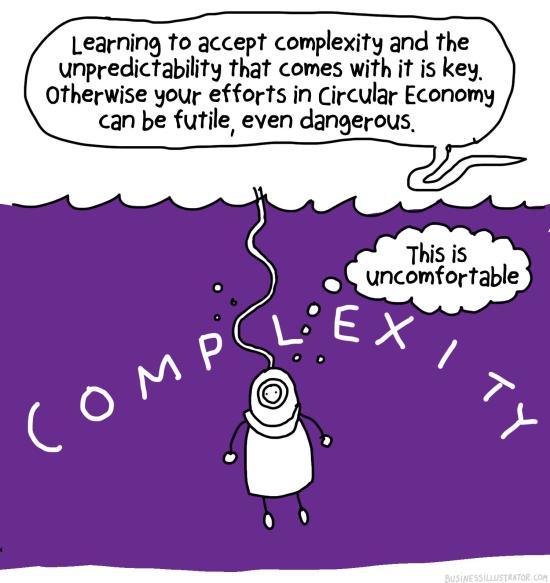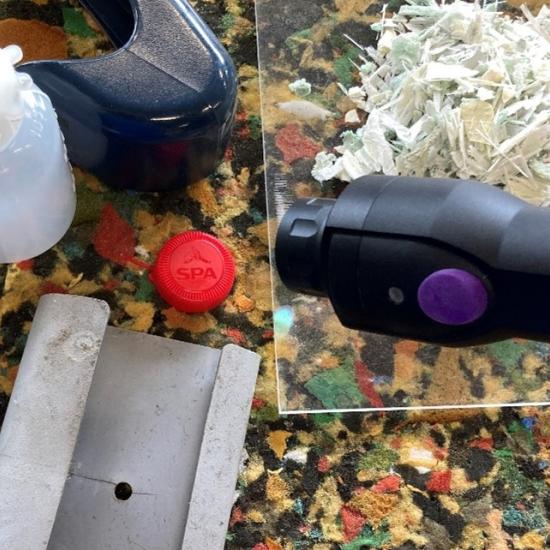How feelings can be used for effective behaviour in unlocking circular challenges
Knowing the approach to solving complex circular problems is not enough to make progress. We cannot ignore that we are depending on others and need to see our actions, reactions and behaviour in relation to others. Why do some cope better while others give up or get frustrated? Based on our experience, we give you some insights and tips.
In a previous article we have already explained how identifying the challenge type (simple, complicated, complex, wicked/chaotic) is key to understanding how to tackle the challenge. Assuming you have identified that your challenge - or at least a significant part of it - is complex, you know that an iterative approach with experiments, small steps and evolutive learning, … is needed to build an emerging practice in your particular context. If this is all we need to know, we would not have problems to realise projects and build up a more circular economy.
Why other people matter
Some of the most frequently heard statements from circular practitioners in companies are “I am convinced of the iterative approach, but other people are not on the same page”, “How can I convince the others to follow this approach?”, “I really want to go for this step-by-step approach, but I need to provide a finished business case first, which seems a contradiction.”
In short, we understand that knowing the approach to solve complex circular problems is not enough to make progress. The key insight is that we are depending on other people. This is why we need to give attention to how we act, react and behave in relation to others.
In this article, we explore why some people can cope better with complex or even wicked circular problems, while others are more likely to giving up or get frustrated.
How do you feel?
Only a few company leaders were inclined to talk about the feelings they experience when setting up, rolling out and trying to scale circular projects. Even if they don’t, we often observe signals that might indicate frustration, disappointment, uncertainty or doubt, as well as joy, excitement and happiness. Especially the more negative feelings are suppressed or hidden.
Frontrunning circular economy practitioners seem to accept this discomfort and reframe this type of feelings in a positive way. They share these feelings and examine where the fear, uncertainty or frustration is coming from, then they set them to work to define future behaviour. In other words, they share the concerns, to search for actions that reduce the frustration or lower the uncertainty and risks. Isn’t it a sign of honest, yet powerful leadership, when uncertainty or doubt are expressed and shared with the team that is invited to contribute to the solution? Most team members are keen to help, especially if their knowledge and input is appreciated. The openness and transparency helps to build the so needed trust. The result of translating the discomfort into actions and triggering interactions within the team unlocks renewed motivation and moves the balance towards more positive feelings.
Our experience
In workshops at companies, we regularly witness that if the team, including the leader, admits to not knowing what the best next step is, a common feeling is recognised. Neither can we (external consultants) as ‘expert’ resolve the issue in itself. Providing exercises with a focus on what is already in place and works well or how such challenges were tackled in the past generates new dynamics. No team member knows what is best, but activating all team members’ knowledge and experience from previous projects and activities generates multiple pathways forward. This is what we want to unlock, by using tools :
Acknowledge your progress tool
Following this type of ‘building on past successes’ often generates a large set of new potential actions and from which key action domains are identified (actions grouped around the same theme). We experience that after such a ‘crisis’ moment the team is more motivated to tackle the issue. It is like a new common goal that emphasizes the trust and need of each other’s contribution.
It is about our own behaviour - the good news is you decide this yourself
To engage team members, to bring co-workers on the same page, to align stakeholders, to increase traction at top management… new behaviour seems to be key. Since you can only change your own behaviour, the freedom to operate is yours. What can you do differently? How can you express a feeling (concern, desire, …) in such a way that it is recognised, confirmed or reframed by others?
Some examples on how we see this happen in practice:
- “I am seriously concerned about the way forward we planned. I don’t dare to take further actions without consulting our distributors first. How do you feel about this? Could we take some time together to share our view on the risks, opportunities, concerns and side conditions of success?“
- “Until recently I felt comfortable with the progress. Since this event, I really experience some frustration that we are not making positive progress. I want to avoid starting arguments about good or bad next actions. Therefore, I suggest exploring a new perspective together, starting from our common goal (i.e. the direction we want to go) and collectively review what helped in similar situations in the past and what action were less helpful.”
- “I see we are not making the expected progress (i.e. provide real observations, according to the nonviolent communication approach). I feel disappointed and frustrated. I feel the need to review our approach. I want our team to be more effective. I suggest we plan a reflection meeting to see what we have realised already and what we try to do differently. Since I don’t know all the answers, I would like you to contribute to this meeting., do you think this is a good idea?“
Observed from a distance, this is the moment when leaders in organisations regard this new situation as ‘too complex to control’. Effective circular practitioners do no longer ‘control’ the business complexity, but rather ‘go with the flow’, benefit from the opportunities and navigate to avoid the largest risks, while striving to make progress in the desired direction.
Having a circular aspiration is very useful and helps as a guide. Each action however will not necessarily provide predictable outcome. Key insights from those frontrunner are: focus on what is learned, try to decide on subsequent steps that provide new insights, reduce the uncertainty gradually and increase the potential success step by step.
Does this sound too fluffy or vague? We recommend the article ‘CEO, become Circular Economy Officer’: the text illustrates in practice how leadership does not ‘control’, but is acting to be sensitive for circular opportunities, while reducing risks.
What does not help in this context, is to externalise the discomfort into disbeliefs on what happens outside your controlled environment. Claims such as “At the end no one cares about circularity, only short-term profit is what it is about” are illustrative. Of course, itis not right or wrong to think and express yourself this way, and once in a while, we all tend to act like this. The point is that it does not generate opportunities to find alternative perspectives and above all, it does not allow yourself to grow as a leader, which we assume is what you want. Therefore, it is a sign of lack of appropriate leadership when complaining and moaning takes over day-to-day decision making, locking the desired progress in disbelieve.
Nurturing the common desire in the team and appreciating what is going well is a more engaging and energising starting point to find new actions and a way forward. This is a reflex you can make your own.
In the article ‘Time to start believing what we know... and act!’ we elaborate on the personal role you have and on the importance of your believes. Read the full article.
The above logic applies in teams as well as in collaborations between people from different companies, while exploring and building new value chains. When we focus inside an organisation we cannot ignore the hierarchical structures. This is what we will explore in a next article.
Give us your feedback!
While writing this series we want to be sure if this type of information is insightful or useful for you.
Therefore, be sure to send us your feedback, reflections, suggestions, cases or examples. It will allow us to create more content in line with what helps you as a circular practitioner.





